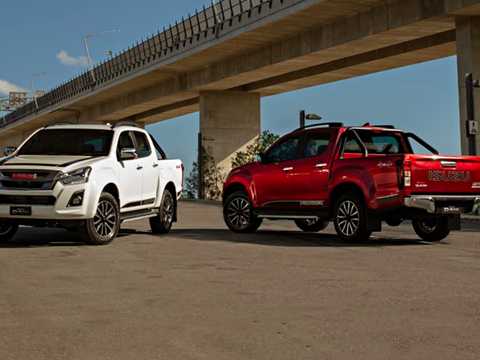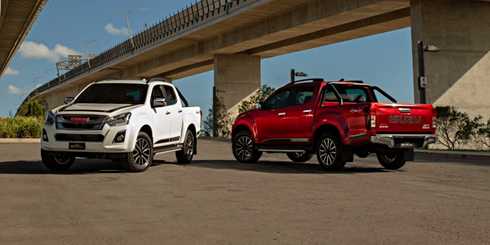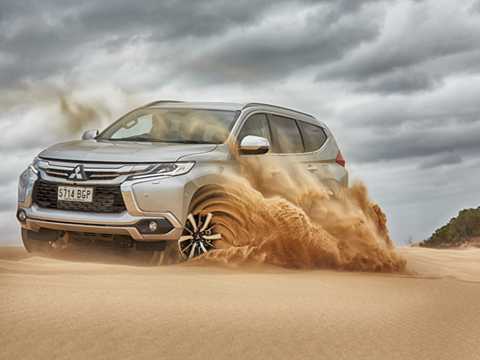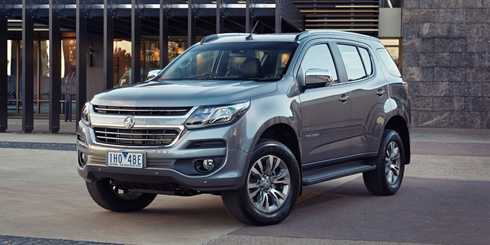Ford Australia flew CarShowroom.com.au to Thailand to test drive the important new Everest – the first-ever Australian-designed and developed seven-seater SUV with proper 4x4 off-road capability.
Although aimed squarely at the popular Toyota Prado 4WD when it launches locally in October, the Everest promises to redefine the segment with leading refinement, ride comfort, driver-aiding technologies, five-star safety, and dynamic capabilities.
Will Ford succeed? It’s in a space the company has not occupied since the demise of the unsuccessful Explorer from North America almost a dozen years ago.
Ford Everest Overview
On first impressions, it is easy to categorise the Thai-made Everest as the replacement for the long-lived (and Australian-built) Territory. Both basically offer a high-riding wagon with seven seats.
But with a 4x4-capable body-on-frame construction based on the same locally engineered T6 architecture as the latest Ranger pick-up truck, this is an altogether different beast, with almost everything from the windscreen back unique to the newcomer (including the Watt’s Link coil-spring suspension set-up, usurping the Ranger’s leaf springs).
From $54,990 for the base Ambiente, the Everest plays in the premium end of its segment. The Blue Oval brand defends the ambitious pricing by claiming class-leading levels of comfort and handling which – we’re told off the record – might make Land Rover and even BMW take notice, let alone Toyota. No pressure to perform there then, Mr Ford.
Standard features across the range include seven airbags, seven seats, an on-demand 4WD system with a Land Rover-style Terrain Management System, reverse camera, rear-parking sensors, touchscreen multimedia with Bluetooth phone and audio streaming, a full-sized spare wheel, and a 3000kg towing capacity rating.
.
2015 Ford Everest Line up:
| Ambiente 4WD 3.2 TDCi | 6-speed auto | $54,990 |
| Trend 4WD 3.2 TDCi | 6-speed auto | $60,990 |
| Titanium 4WD 3.2 TDCi | 6-speed auto | $76,990 |
Key features by variant can be found here - Key Features Ford Everest
Ford Everest Engine
Initially, only one engine and transmission combination will be made available in Aussie-bound Everests – a 143kW/470Nm 3.2-litre five-cylinder Duratorq turbo-diesel based on the unit serving the Ranger, sending (in normal on-road mode) 60 per cent of torque to the rear wheels via a six-speed automatic with a sequential shift option for manual ratio selection.
Aided by economy-focussed tuning, the average combined fuel consumption figure is quoted at 8.5L/100km.
It is rumoured that a 2.2-litre four-cylinder turbo-diesel might step in as a lower-priced, sub-$50,000 base-model entrant once the Territory ceases (along with over 90 years of Australian Ford manufacturing) after next year.
Ford Everest Interior
Far from looking like a tarted-up Ranger inside, the Everest’s cabin is appealingly car-like in its appearance and layout, reflecting Ford’s desire to convey a civilised look and feel.
Other than the confounding lack of telescopic adjustment for the rake-only steering wheel, it’s clear the designers put plenty of thought inside. Excellent instrument dials with crisp digital displays, ample ventilation (appreciated in Thailand’s oppressive humidity!), plenty of storage options, and that handy central infotainment touchscreen with SYNC 2 voice control functionality all make for a family friendly interface.
Key points to remember is more than sufficient space for five adults in the first two rows, with individual sliding and reclinable middle seats, and a rear-most pair that can accommodate a 180cm adult at a pinch – until the clumsy access, hemmed-in headroom, and lack of cushion support start taking their tolls. Kids ought to find it far more suitable, however, aided by nearby air vents, a reading light, and 12-volt charging outlet.
Leather upholstery, sat-nav, and a powered tailgate don’t make an appearance until the mid-range Trend, but otherwise Ford hasn’t been too mean with the Ambiente’s spec, which includes middle-row climate control, and (effective) active noise-cancellation tech.
From a tall but shallow amount of space with all backrests up, the Everest’s luggage area extends to 2010 litres with the 50/50 folding third-row seats dropped down.
Ford Everest Exterior and Styling
As with the packaging and engineering, the Everest’s handsome and clean design is the handiwork of Ford Australia. Started almost four and a half years ago, the look is meant to convey toughness up front, backed up by wide-stance wheel arches and muscular rear haunches.
Refinement-enhancing aerodynamic detailing abounds, with careful attention paid to cutting wind noise from around the pillars and mirrors.
Ford Everest Issues
Annoyingly, the middle seat’s 60/40 divide is set-up to favour left-hand drive markets, meaning that in Australia, two occupants (rather than just one) have to get out on the safer footpath side of the vehicle to allow the mechanism to tilt and slide forward for people to access the third row.
Some of the lower-lying plastic interior trim is of the hardy but cheap variety, undermining the premium image Ford is attempting to convey.
Finally, over the relatively short drive route in Thailand, we found that the trusty old 3.2-litre five-cylinder turbo-diesel can sound a little coarse under load, or when revving out.
Ford Everest On (and Off) the Road
With only about 150km of testing, over mainly straight sealed roads in Northern Thailand, our overall impressions of the Everest are fairly limited. However, three very clear defining characteristics should be directly transferable in Australian conditions.
Firstly, intelligent transmission calibration ensures the five-pot diesel’s off-the-line acceleration is both strong and smooth, drawing upon a substantial well of torque to help propel the hefty SUV along without effort or hesitation. Four adults and their luggage did not seem to impact on the Ford’s available performance. Only when extending the engine’s revs towards the red line (during an overtaking manoeuvre, for example) does the Duratorq engine’s inherent vocal nature become apparent.
Secondly, in the 18-inch Trend and 20-inch Titanium-spec vehicles as tested, the Everest’s ride quality is remarkable. Supple yet controlled, the suspension just glides over most surfaces – even roads with crumbling edges and frequent potholes – for an impressively isolated cabin experience. We reckon the Ford’s refinement here will shame most monocoque-bodied SUV/crossover alternatives.
Finally, the electric power steering is also a revelation for this sort and size of vehicle, moving progressively from two-finger lightness in tight lower-speed turns, to a heavier yet still smooth and controlled attitude through faster corners. Ford reckons its ‘dynamic DNA’ has filtered through completely despite the Everest’s separate chassis construction, and we’re inclined to agree. This is a confident and capable on-road handler, with a decent amount of feedback and response, which ought to please keener drivers.
A moderately demanding 4x4 course offered up an opportunity to test the 4WD system’s standard Terrain Management System – which allows the driver to switch from 60-40 rear-wheel biased Normal on-road driving to a quartet of contrasting off-road settings. Involving Snow/Mud/Grass, Sand, Rock, and hard-core Low-Range, all vary the transmission, traction control, and throttle sensitivity calibration.
Assisted by an electronic locking rear differential, HDC Hill Descent Control, Hill Launch Assist, plenty of coil-spring suspension wheel travel, sufficient approach/departure angles, a competitive 225mm ground clearance, and 800mm of water-wading ability, the Everest is a true bush-bashing machine – and this makes its on-road dynamic capabilities all the more laudable. Ford says the SUV can move forward even with three wheels off the ground. You can’t do that in a Territory.
Ford Everest Competition
The Everest has been positioned to be near or lineball with the equivalently specified Prado diesel variant’s prices, with roughly similar equipment levels.
At the time of writing, the Ford has the upper hand in terms of advanced driver-aided tech – and that includes Lane Keeping and Lane Departure warning systems, Blind Spot Warning with Cross-Traffic Alert, Autonomous Emergency Braking, Adaptive Cruise Control, Roll Stability Control, Trailer Sway Control, and Active Park Assist – which helps manoeuvre the vehicle into tight spots.
It will be interesting to see what what the all-new Mitsubishi Challenger offers when it goes on sale later this year.
Ford Everest Verdict
Ford has worked for more than four and a half years to develop a seven-seater SUV 4x4 wagon with premium levels of refinement, proper on-road steering and handling dynamics, and decent off-road capability.
On first acquaintances at least, the Australian team at Broadmeadows seems to have achieved its goals admirably, and have sure exceeding our expectations of what a ladder-frame chassis 4WD can do – even one based on the leading Ranger truck.
Obviously there are a few foibles – namely the loud 3.2-litre Duratorq diesel and the lack of steering column reach adjustment – but on the evidence experienced in Thailand, the Everest’s rivals – beginning with Toyota – ought to be very worried indeed. Australian car manufacturing may be winding down, but we’re still able to deliver world-class vehicles.











































